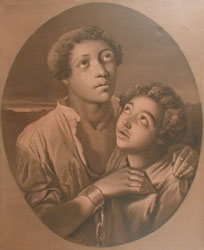Baxter responded to the prevalence of photography by the issue
of his Baxterotypes and sepia prints. As photographs were called
"Daguerrotypes" after Daguerre, so Baxter called his
"Baxterotypes" after himself. These prints were sold
in sepia only and never in colours.
Speaking
about this process, he said in an advertisement in January, 1855:
"This process possesses great advantage over Daguerrotype,
photograph, or Colotype, in the certainty of each copy being equal
in quality, every one of them being a complete facsimile of the
first impression. They can be produced in the most cloudy as well
as the brightest weather, and at a cost considerably below those
which are executed by the Daguerrotype, Colotype, or photographic
process… Pictures executed by the Baxterotype process retain
their beauty in all climates, the action of the atmosphere not
affecting their production in the least degree."
